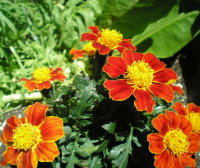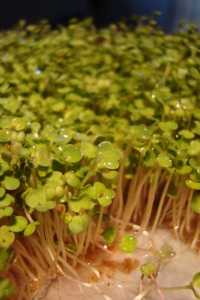
One thing that keeps me happy over winter are my bonsai rocket gardens. Leaving the house for work when it’s dark and getting home in the some disposition, doesn’t allow time for garden therapy. So I’ve been bringing it inside. I spread them on to paper towels on an ice cream container lid, sprinkle water over it once a day and here in winter it usually takes 4 – 6 days to have yumminess. Then I just use them in everything.
High in nutrients and vitamins A, B, C and E, rocket (Eruca spp.) rocks over winter. The sprouts add a nice bit of warmth to any vegetable dish. I use them as a side vegetable for just about anything, sprinkle them on my tomato soup, add them to cheese sandwiches.
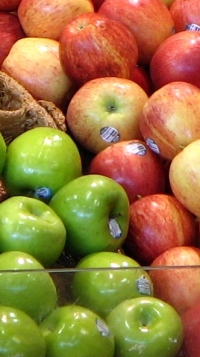
A produce wash has just enough kick to it to more effectively cleanse the surface of the fruit and wash away contamination.
- 1 cup water
- 1 cup distilled white vinegar
- 1 tablespoon baking soda
- 20 drops grapefruit seed extract (available at your local health food store or you can substitute lemon juice in a pinch)
- Combine all ingredients and transfer to a spray bottle with a pump. Spray mixture on produce (avoid using on mushrooms), let sit 5 to 10 minutes and rinse.
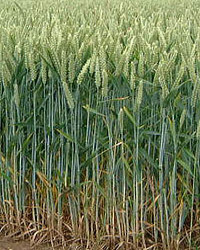
I was thinking that if it all got too dire, I could live on chocolate for the two months. That was until I found out that nearly every chocolate I’ve ever loved contains soy lecithin! How very, very rude.
There will be informed progress reports, a little exploration of the issues… There may even be some whineing and a little gnashing of teeth… But there won’t be any crackers, bread, pasta, tofu, sushi, beer, chocolate …
Got any great suggestions for gluten-free, soy-free products? Please let me know in the comments.

Entrachyadids are a type of earthworm, and not a nematode as I first feared. They are a sign that the soil is too acid which is a result of putting in too many kitchen scraps. Although, the entrachyadids don’t do any damage, we will be adding lime to the beds to reduce the acidity.
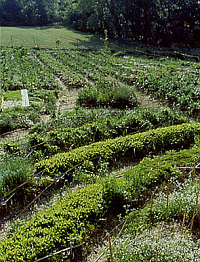
I have to admit, I’ve become a little obsessed by these beautiful beds, all curved and mounded in sweeping lines. I also love the very way they are constructed, in sort of gentle sweeping movements. Due to my terrain I’m not able to do them at my house, so I’ve been eyeing up other people’s gardens to work on.
Anyway, here are notes on the video including links to some other pieces on Emilia…
Emilia Hazelip – Synergistic Gardening
Based on work of Masanobu Fukuoka, The One Straw Revolution. 1978. Rodale.
Need to modify systems to our own location. Want to get high-yields whiile maintaining the soil’s own fertility.
No cultivation
No chemical or organic fertilisers
No chemical treatments
No compaction of the soil
Set out beds with sticks and then clear paths for your feet, mounding the soil into beds. Mounds should be 4 feet wide with 20 inches for the path. 10 – 30 inches for the beds deeper the beds the more room for the roots. Give them any shape you wish but make sure you can reach the centre of the beds easily.
Sheet mulch – cover the ground with cardboard. A good way to clear ground and you can grow potatoes at the same time.
Plants synthesise from light. Plants only take 2.5% of their mass from the soil. The rest comes from air and light. Plants give back much more to the soil then they take out.
Use marigolds all through the garden.
Beans and peas are legumes and fix nitrogen into the soil. You can use ash, which contains potash, to help grow your beans. This provides free fertiliser for your soil, the bacteria providing many benefits to your plants. These plants will also provide a living mulch between your plants. After harvest, the plants can simply be cut off, leaving the roots in the soil. the plant matter can simply be left on top of the beds. providing further mulch.
Synergistic gardening uses compost in the greenhouse or flats to start the plants – it doesn’t ‘force feed’ your soil with it.
Onions, garlic and leeks can be planted on the side of the garden beds. They function as pests controllers as well as being nutritious. They can be intermixed with other plants like lettuce or swiss chard.
Many plants reseed themselves – an advantage of letting plants finish their life cycle.
Mulching the mounds – Newspaper, cardboard, straw, leaves, wool. You can use grass clippings as mulch, but make sure you cut it and let it dry before it starts to seed. The first year the soill will be eating the mulch but as the organic contents in the soil improves, the amount of mulch needed will reduce. You will still need to weed, but it will gradually reduce – it’s all part of the evolving cycle.
Ducks (Indian Runner ducks), some birds, hedgehogs, lizards all eat slugs. Copper cuffs, or ones made from coke cans can protect plants from slugs.
When harvesting plants like lettuce, cut above the ground allowing the plant a chance to regrow, or providing dead matter for the soil to feed on.
Don’t stand on your beds! this will damage and compact the soil
Flowers are very important as they may attract beneficial insects, secrete chemicals to protect other plants (eg marigolds), or have edible, medicinal, or economic benefits as well as looking very attractive.
Diversity = a healthy, rich soil. Plants lots of plants with different root structures and leave those root structures in the soil when you harvest. Emilia says that force feeding your soil will create an imbalance or indigestion – let things work naturally – synergistically.
In nature, nothing happens in exactly the same way twice in the same spot. Diversify.
More information
The Synergistic Agriculture of Emilia Hazelip at the Fukoka Farming website
Loving our Seedy Sundays. Had a fantastic turn out last weekend to see the lovely Sarah Frater from Edible Gardens. With so much knowledge and experience, it was a really interesting session on fruit trees. It’s a popular topic right now – articles in the Kapiti Observer each week by Kath Irvine, a glorious NZ Gardener special (the species harvesting guide is pure gold) and fruit tree providers simply running out of stock. Mental note: must do lots of preservation posts this season.
Swap table was very exciting. I had been a little worried that we’d end up each month with swap tables where everyone had brought the same thing – absolutely wrong! I’m so impressed by the variety of things – feverfew seedlings, orach seeds, mini kiwifruit, plenty of lovely bunches of different herbs, three types of sunflower seeds, teasels…….
Lots of great conversations too – lots of really interestig people doing interesting things and really wanting to get involved. Lots of interesting local initiatives including:
– Transition Towns Kapiti Food Forest,
– A Gardening Group looking to form and help people in their own backyards,
– Raumati South Community Garden,
– And plenty of people interested in seed-saving and starting a Kapiti Community Seed Bank.
If you want to know anything more about any of these, email me and I’ll pass you on to the right people. Or come to the next SS.
Next Seedy Sunday is July 19, 2pm Kapiti Community Centre. Guest speaker to be confirmed soon.
I, like anyone else who has heard of it, am a massive fan of TED. To actually hear some of the world’s most inspirational, influential and downright clever people speak about topics for which they have a deep passion is simply phenomenal.
The next stage of TED evolution has begun with TEDx – a program of local, self-organized events that bring people together to share a TED-like experience. So expect a lot more content coming on any topic you may be interested in.
In this TEDx Talk, Jane Poynter tells the story of BioSphere2 and her experiences in relating to the ecosystem afterwards. Giving you a real sense of the connectivity of all things, this is a must-see for anyone interested in the natural world.
Thanks to Paul Reynolds for the heads up!

I’m trying to do some research into non-running bamboos, a.k.a. sympodial varieties, to provide some shelter. That seems to be the main purpose for growing bamboo in NZ. I’ll be able to use stems as garden stakes, maybe for some building projects and if I get the right variety, to put in my sushi.
Clumping bamboos generally grow slower then the running-type, a.k.a. monopodial varieties. New shoots only develop close to older stems, mainly in autumn, but twice annually in rich soil. They harden over winter and put on leaf growth in spring and summer.
Non-running bamboos (Clumping or sympodial species) available in New Zealand after the jump Read more

